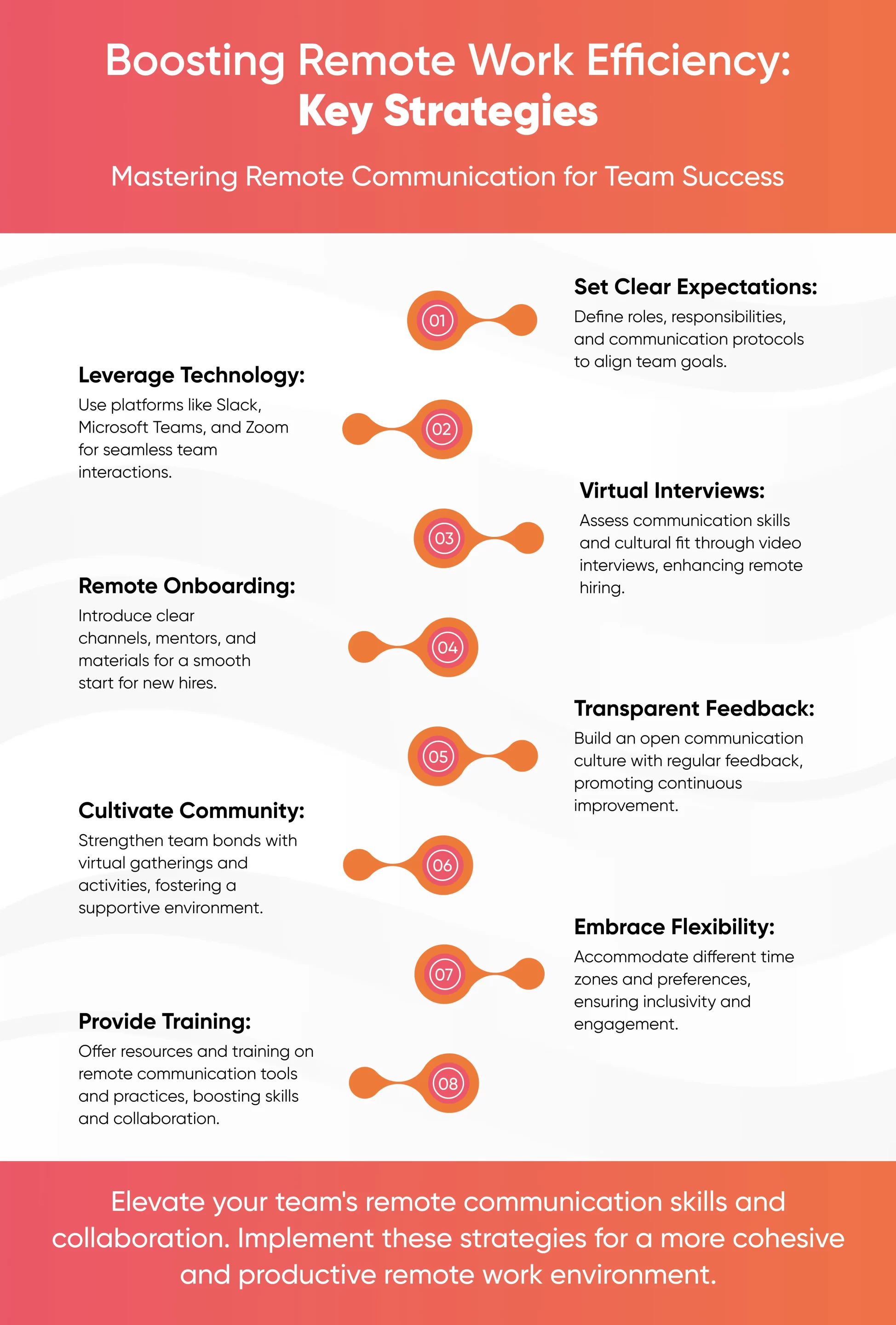In the age of remote work, effective communication is more crucial than ever, especially during the hiring process. As companies embrace distributed teams, the need to foster clear and efficient remote communication from the outset becomes paramount.
Recent statistics underscore the importance of prioritizing remote communication in the hiring process. Studies show that more than 50% of workers report a loss in productivity due to inefficient communication. Additionally, 45% of workers feel more connected using digital communication.
In this blog post, we’ll delve into various strategies and tools to enhance remote communication specifically tailored for the hiring process. From leveraging technology to implementing transparent communication channels, we’ll explore actionable tips for effective remote team collaboration and project management.
What is Remote Communication?

Remote communication means talking, sharing thoughts, and passing messages with others when you’re not together in the same place.
Instead of talking face-to-face, you use things like email, texting, video calls, or phone calls to chat. It’s like having a conversation without being in the same room.
This kind of communication is super important for people who work from different locations or teams spread out across the world. In fact, it helps everyone stay connected and work together smoothly, no matter where they are.
Furthermore, remote communication fosters flexibility and allows individuals to balance work and personal life more effectively. Workers can easily collaborate from the comfort of their homes or while traveling.
What are the Types of Remote Communication?

Exploring Types of Remote Communication: Synchronous and Asynchronous
Virtual remote communication can be broadly categorized into two main types: synchronous communication and asynchronous communication. To ensure efficient clear communication, it is crucial to understand both types of remote communication.
-
Synchronous Communication
Synchronous communication refers to real-time interactions where participants engage in communication simultaneously. This includes activities such as video conferencing, phone calls, and instant messaging.
Synchronous communication allows for immediate feedback and collaboration. Thus, making it ideal for discussions, brainstorming sessions, and quick decision-making.
-
Asynchronous Communication
Asynchronous communication, on the other hand, occurs when communication takes place at different times. In this type of remote communication, participants do not need to be present simultaneously. For Example, email, shared documents, and discussion forums.
Asynchronous communication provides flexibility, allowing individuals to respond at their convenience. Furthermore, it reduces the need for everyone to be available simultaneously.
Thus, this type of communication is beneficial for exchanging detailed information and providing updates.
What are the Ways to Improve Remote Communication?

Improve Remote Communication
Improving remote communication is essential for fostering collaboration and productivity in distributed teams. By implementing effective strategies and leveraging appropriate tools, teams can overcome geographical barriers.
Let’s dive into tips for effective remote team communication and collaboration tools.
1. Setting Clear Expectations:
One of the key aspects of remote communication in the hiring process is setting clear expectations from the beginning. Job descriptions should clearly outline the role, responsibilities, and communication requirements. This helps candidates understand what is expected of them in terms of remote team communication and collaboration.
2. Leveraging Technology:
Utilizing communication and collaboration tools is essential for effective remote team communication. Platforms like Slack, Microsoft Teams, or Zoom facilitate real-time communication, file sharing, and video conferencing. Thus, fostering seamless interactions among team members regardless of their location.
3. Conducting Virtual Interviews:
Virtual interviews have become commonplace in remote hiring processes. Conducting video interviews allows recruiters to assess candidates’ communication skills and cultural fit.
Moreover, it provides a more comprehensive understanding beyond what’s written on a resume. In fact, virtual interviews gain even greater significance in remote hiring scenarios.
4. Implementing Remote Onboarding Practices:
Effective remote communication doesn’t end with the hiring process, it extends into onboarding. Implement remote onboarding practices that include clear communication channels, designated mentors, and comprehensive training materials. Furthermore, ensure that new hires feel supported and integrated into the team from day one.
5. Encouraging Transparent Feedback:
Encouraging transparent feedback is essential for fostering a culture of open communication within remote teams. Managers should regularly solicit feedback from team members and provide constructive criticism when necessary.
This promotes continuous improvement and ensures that issues are addressed promptly.
Key Strategies for Improving Work Efficiency
6. Cultivating a Sense of Community:
Despite physical distance, remote teams can still foster a sense of community. With virtual gatherings, team-building activities, and informal communication channels, they can reinforce connections.
Moreover, managers must find creative ways to communicate with remote employees. These initiatives help strengthen bonds among team members, leading to more effective collaboration and communication.
7. Embracing Flexibility:
Flexibility is key when it comes to remote communication in the hiring process. Recognize that team members may have different communication preferences and schedules due to varying time zones and personal obligations. Therefore, embracing flexibility ensures that everyone feels heard and accommodated.
8. Providing Training and Resources:
Offering training and resources on effective remote communication tools and practices equips team members with the required skills. These skills are needed to succeed in a remote work environment.

From webinars to online courses, investing in continuous learning helps improve team communication and collaboration.
5 Remote Communication Tools
Remote communication tools have become essential in today’s work environment, especially with the increase in remote and hybrid work models. Here are five popular remote communication tools that facilitate collaboration and communication among teams:
- Zoom: This video conferencing tool is widely used for virtual meetings, webinars, and live chat. Its user-friendly interface and robust features like screen sharing, recording options, and breakout rooms make it a favorite for both professional and personal use.
- Slack: Slack is a powerful messaging app for teams that makes communication faster and more organized. It integrates with a wide range of other services and features channels for group discussions, direct messaging, and the ability to share files and documents seamlessly within conversations.
- Microsoft Teams: Part of the Microsoft 365 suite, Teams is a comprehensive collaboration tool that integrates chats, video calls, and meetings with the extensive capabilities of Microsoft products like Word, Excel, and PowerPoint. It’s particularly useful for organizations that rely on other Microsoft services.
- Google Meet: A secure and reliable video conferencing solution by Google, which is deeply integrated with Google Workspace. It allows users to easily schedule meetings through Google Calendar, join calls from their browser, and collaborate through real-time sharing of Google Docs, Sheets, and Slides.
- Asana: While primarily a project management tool, Asana helps remote teams coordinate and track their work from daily tasks to strategic initiatives. It allows users to plan projects, assign work to teammates, specify deadlines, and communicate about tasks directly in the platform.
Benefits of Remote Communication
Remote communication tools have democratized workplaces, making them more inclusive and flexible. They allow teams to:
- Stay connected across different time zones.
- Reduce overhead costs associated with physical office spaces.
- Enhance work-life balance by cutting down commute times.
Challenges of Remote Communication
While advantageous, remote communication also presents challenges such as:
- A lack of personal interaction which can lead to feelings of isolation.
- The potential for miscommunication due to the absence of non-verbal cues.
- Over-reliance on technology which can lead to digital fatigue.
Real-life examples of Effective Remote Communication

tips for effective remote team communication and collaboration tools
Effective remote communication is vital for seamless collaboration in distributed teams. It involves clear communication channels and the use of appropriate tools. Let’s look at businesses that understand the matrix.
-
Automattic:
Automattic, stands as a pinnacle of remote work success, largely due to its creation of WordPress. With a workforce of over 1100 employees spanning 77 cities, Automattic has demonstrated the immense potential of remote collaboration on a global scale. This success is attributed to the dedication and tireless efforts of its team members.
A Co-Founder of Automattic, Matt Mullenweg, emphasizes the importance of engagement as a driver of growth and success. In an interview with Inc., Matt challenges traditional notions of productivity, rejecting metrics like early rising or long hours in favor of a focus on creation and value addition.
Furthermore, he advocates for inclusive and employee-centric cultures.
-
Zappier:
Zapier emerged as a pioneering remote work company, rooted in the concept of working from home. Its founding story is intriguing: all three founders resided in the same city but faced scheduling conflicts. Hence, compelling them to work separately according to their individual plans.
To overcome this challenge, they opted for independent work while maintaining remote meetings to collaborate effectively. This remote team collaboration proved incredibly successful, propelling Zapier from a side hustle to a powerhouse with over 2000 integrations.
Today, millions of professionals rely on Zapier’s services to streamline their remote workflows.
Conclusion:
In today’s remote work landscape, mastering remote communication in the hiring process is essential for building successful distributed teams. Clear expectations, technology use, and open communication foster thriving remote teams.
Moreover, effective communication ensures remote teams start strong and succeed in today’s landscape. Utilizing these strategies not only enhances team productivity but also contributes to a positive remote work experience for all involved. A remote IT staffing company can further help you with remote communication.
Also Read: The Ultimate Guide: How to Hire Remote Developers
Frequently Asked Questions (FAQs)
-
How can virtual leaders ensure effective communication with remote workers?
Virtual leaders can ensure effective communication with remote workers by setting clear expectations and fostering a culture of transparency and inclusivity.
-
Why is remote communication important?
Remote communication is important because it enables seamless collaboration among distributed teams. Moreover, it facilitates the timely exchange of information and promotes employee engagement and satisfaction.
-
What is local communication and remote communication?
Local communication involves interactions between individuals who are physically present in the same location. Likewise, remote communication occurs between individuals or groups who are geographically separated and rely on digital tools to communicate.
-
What are the different methods of remote communication?
Different methods of remote communication include email, instant messaging, video conferencing, phone calls, and virtual meetings.
-
What is the difference between local and remote communication?
Local communication refers to the interaction that occurs within the same physical space or local network, such as conversations, meetings in person, or data exchange over a home or office network. It typically involves direct, immediate interaction without reliance on external networks.
Remote communication, on the other hand, involves connecting with people or systems that are not in the same physical or local network environment. This includes emails, video calls, and data sharing over the internet, relying on telecommunications networks to bridge the geographical gap between parties.








